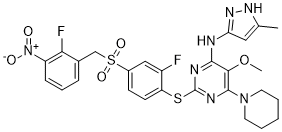Centrinone-B (LCR323; LCR-323; LCR 323) is a novel and reversible polo-like kinase 4 (PLK4) inhibitor with potential anticancer activity. With a Ki of 0.59 nM, it exhibits >1500-fold selectivity in inhibiting PLK4 in comparison to Aurora A and Aurora B.
Physicochemical Properties
| Molecular Formula | C27H27F2N7O5S2 |
| Molecular Weight | 631.67 |
| Exact Mass | 631.148 |
| Elemental Analysis | C, 51.34; H, 4.31; F, 6.02; N, 15.52; O, 12.66; S, 10.15 |
| CAS # | 1798871-31-4 |
| Related CAS # | Centrinone;1798871-30-3 |
| PubChem CID | 118704753 |
| Appearance | Light yellow to yellow solid powder |
| Density | 1.5±0.1 g/cm3 |
| Boiling Point | 904.9±75.0 °C at 760 mmHg |
| Flash Point | 501.1±37.1 °C |
| Vapour Pressure | 0.0±0.3 mmHg at 25°C |
| Index of Refraction | 1.687 |
| LogP | 3.77 |
| Hydrogen Bond Donor Count | 2 |
| Hydrogen Bond Acceptor Count | 13 |
| Rotatable Bond Count | 9 |
| Heavy Atom Count | 43 |
| Complexity | 1030 |
| Defined Atom Stereocenter Count | 0 |
| SMILES | S(C1C=CC(=C(C=1)F)SC1=NC(=C(C(=N1)N1CCCCC1)OC)NC1C=C(C)NN=1)(CC1C=CC=C(C=1F)[N+](=O)[O-])(=O)=O |
| InChi Key | UPZNTUYHCRQOIQ-UHFFFAOYSA-N |
| InChi Code | InChI=1S/C27H27F2N7O5S2/c1-16-13-22(34-33-16)30-25-24(41-2)26(35-11-4-3-5-12-35)32-27(31-25)42-21-10-9-18(14-19(21)28)43(39,40)15-17-7-6-8-20(23(17)29)36(37)38/h6-10,13-14H,3-5,11-12,15H2,1-2H3,(H2,30,31,32,33,34) |
| Chemical Name | 2-[2-fluoro-4-[(2-fluoro-3-nitrophenyl)methylsulfonyl]phenyl]sulfanyl-5-methoxy-N-(5-methyl-1H-pyrazol-3-yl)-6-piperidin-1-ylpyrimidin-4-amine |
| Synonyms | LCR-323; CentrinoneB; LCR 323; Centrinone B; LCR323; Centrinone-B |
| HS Tariff Code | 2934.99.9001 |
| Storage |
Powder-20°C 3 years 4°C 2 years In solvent -80°C 6 months -20°C 1 month |
| Shipping Condition | Room temperature (This product is stable at ambient temperature for a few days during ordinary shipping and time spent in Customs) |
Biological Activity
| Targets | PLK4 (Ki = 0.59 nM); PLK4 (G95L) (Ki = 497.53 nM); Aurora A (Ki = 1239 nM); Aurora B (Ki = 5597.14 nM) |
| ln Vitro | Centrinone-B (LCR-323) has a Ki of 0.59 nM and is a powerful and highly selective PLK4 inhibitor. With Kis of 1239 nM and 5597.14 nM, respectively, centrinone-B binds to Aurora A and Aurora B very weakly. In vitro, centrinone-B (LCR-323) shows >1000-fold selectivity for Plk4 over Aurora A/B, and at concentrations that deplete centrosomes, it has no effect on the phosphorylation of the Aurora A or B substrate in cells[1]. Through inhibition of PLK4, centrinone-B (LCR-323) (0-200 nM) dramatically reduces the viability of PLK4-centriole conjunction melanoma cell lines, with the exception of the p53 mutant SK-MEL-28. uman melanoma cell lines undergo apoptosis in response to Centrinone-B (LCR-323)-induced PLK4 inhibition[2]. |
| ln Vivo | In white 384-well plates, all kinase assays are conducted. Equal volumes of the following are used in Plk4 assays: (1) purified 6xHis-tagged human Plk4 kinase domain (aa 2-275), which was expressed in E. coli and purified using Ni-NTA affinity chromatography; (2) 2X reaction buffer comprising 50 mM HEPES pH 8.5, 20 mM MgCl2, 1 mM DTT, 0.2 mg/mL BSA, 16 μM ATP, and 200 μM A-A11 substrate (amino acid sequence: TPSDSLIYDDGLS). After the reaction is complete, the pH is 8.0 and the Plk4 concentration ranges from 2.5 to 10 nM. Stocks of DMSO are supplemented with inhibitors arranged according to dose response. At 25°C, reactions can last for four to sixteen hours. Using the ADP-Glo reagent, detection is accomplished. The Infinite M1000 plate reader is used to measure luminosity. Kis is determined from IC50 data and data are fitted using Prism[1]. |
| Cell Assay | The CytoTox-Glo assay is used to assess the impact of centrinone B on the viability of normal melanocytes and melanoma cell lines. In a nutshell, cells are counted, plated in a 96-well plate, and treated with centrinone B for 48 hours the following day. After that, the cells are incubated with AAF-Glo substrate (alanyl-alanylphenylalanyl-aminoluciferin) for 15 minutes, which gives rise to a luminescent signal that indicates a distinct intracellular protease activity linked to cytotoxicity (dead-cell protease). After adding digitonin to lyse the remaining viable cells, the luminescent signals of dead cells (caused by centrinone B) are subtracted from the total number of dead cells to determine the viability of the cells. Relative light units (RLU) for viable cells are used to represent data[2]. |
| References |
[1]. Cell biology. Reversible centriole depletion with an inhibitor of Polo-like kinase 4. Science. 2015 Jun 5;348(6239):1155-60. [2]. Centriole Overduplication is the Predominant Mechanism Leading to Centrosome Amplification in Melanoma. Mol Cancer Res. 2018 Jan 12. |
Solubility Data
| Solubility (In Vitro) | DMSO: ~25 mg/mL (~39.6 mM) |
| Solubility (In Vivo) |
Solubility in Formulation 1: 2.5 mg/mL (3.96 mM) in 10% DMSO + 90% (20% SBE-β-CD in Saline) (add these co-solvents sequentially from left to right, and one by one), suspension solution; with sonication. For example, if 1 mL of working solution is to be prepared, you can add 100 μL of 25.0 mg/mL clear DMSO stock solution to 900 μL of 20% SBE-β-CD physiological saline solution and mix evenly. Preparation of 20% SBE-β-CD in Saline (4°C,1 week): Dissolve 2 g SBE-β-CD in 10 mL saline to obtain a clear solution. Solubility in Formulation 2: ≥ 2.5 mg/mL (3.96 mM) (saturation unknown) in 10% DMSO + 90% Corn Oil (add these co-solvents sequentially from left to right, and one by one), clear solution. For example, if 1 mL of working solution is to be prepared, you can add 100 μL of 25.0 mg/mL clear DMSO stock solution to 900 μL of corn oil and mix evenly. (Please use freshly prepared in vivo formulations for optimal results.) |
| Preparing Stock Solutions | 1 mg | 5 mg | 10 mg | |
| 1 mM | 1.5831 mL | 7.9155 mL | 15.8311 mL | |
| 5 mM | 0.3166 mL | 1.5831 mL | 3.1662 mL | |
| 10 mM | 0.1583 mL | 0.7916 mL | 1.5831 mL |
